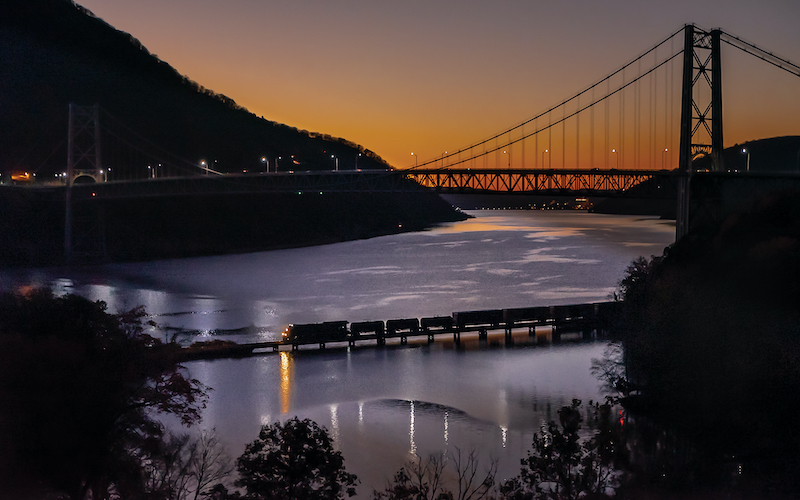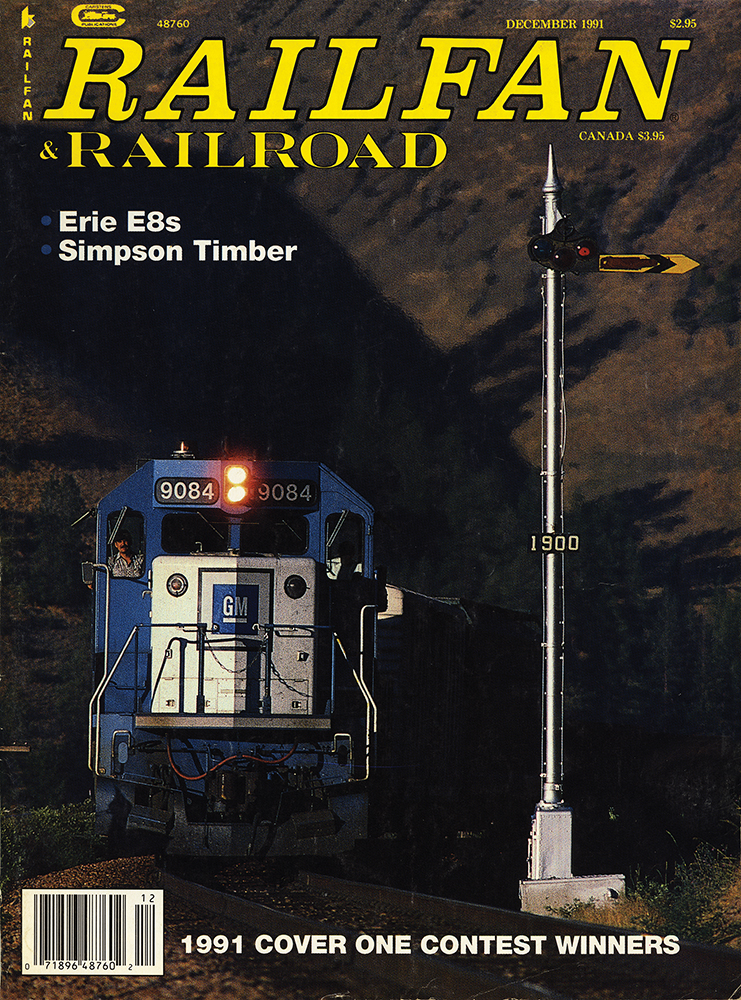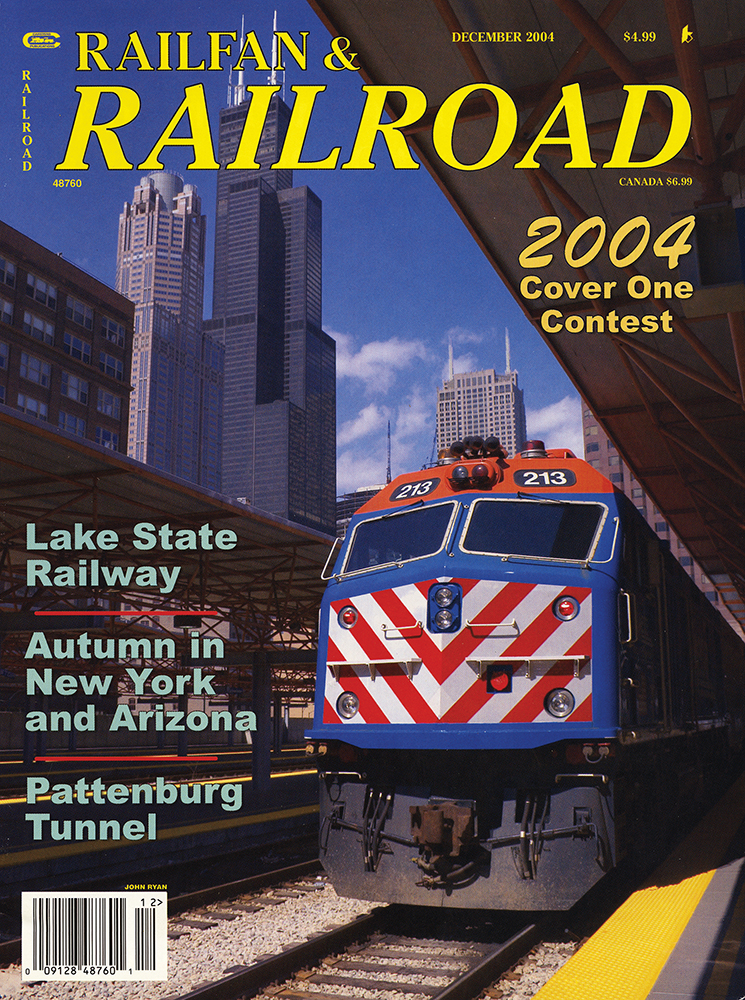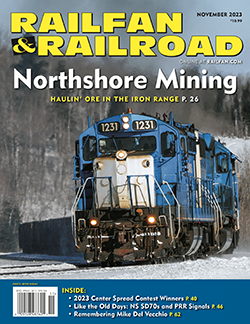By Justin Franz
Thirty-five years ago this month, Railfan & Railroad published the first winner of its soon-to-be-annual “Cover One” photo contest, a striking night shot of Grand Trunk Western 2-8-2 4070 simmering on a September evening in 1988. Prior to that issue, the best way to get a cover photo was to write a feature in the magazine (that’s still true today). But that year, the editors decided to try something different and put on a contest in conjunction with the National Railway Historical Society convention, which was being held then in the magazine’s home state of New Jersey. Not only would the winners (first and second places, plus nine runners-up) have their images in the November 1988 issue, but the top images would be put on display during the NRHS “Garden State in ‘88” convention.
Interestingly, that wasn’t the first time the magazine had hosted a photo contest. About a decade earlier, Railfan (no “& Railroad” just yet) had teamed up with the High Iron Company’s Ross Rowland to hold an American Freedom Train Photo Contest celebrating the steam-powered museum train that had crisscrossed the nation in 1975 and 1976. The contest had two classes (black & white and color) and four categories (Action, On Display, Night, and Human Interest) and could be sent to “P.O. Box 1776” in New York City. By the March 15, 1977, deadline, 1,370 entries had been sent and two months later, a four-judge panel (including Rowland, Editor Jim Boyd, and Publisher Harold Carstens) gathered to select the winners. The winning images were published in the October 1977 edition. A few years later, the magazine again teamed up with Rowland for another photo contest, this time focusing on Chesapeake & Ohio 4-8-4 614 leading coal trains in West Virginia to gather data in an effort to develop a modern production steam locomotive — that, of course, never happened.
After that initial Cover One contest in 1988, the editorial staff decided to make it an annual event, with the winner gracing the cover of the December issue of the magazine. The rules of the contest were generally pretty simple — any photo of a railroad subject was eligible so long as it could be suitably cropped vertically for a cover. There also had to be room for the magazine’s flag at the top and the small white UPC code on the bottom left. In 1990, the editorial staff decided to add a theme — “Trains in Autumn Color.” The contest went back to its “anything goes” format in 1991 and there was a suggestion that the 1992 competition would have a winter theme, but the winner that year (a spring view of the St. Lawrence & Atlantic train at Berlin, N.H., by Les MacDonald) suggests someone forgot that when it came time to announce the contest. Finally, in 1995, the magazine held the contest with the winter theme, but otherwise it was always an all-season affair.
The Cover One contest would continue until the mid-2000s when a change in postal regulations threw a wrench in things. Prior to that, subscriber copies were shipped in plastic bags or loose with the address of the recipient on a small label stuck to the cover. But in 2006, the U.S. Postal Service began requiring that the address be printed directly on the cover on a rather unsightly white rectangle. This is why there’s usually a color band across the bottom of your subscriber copy to make way for that box. The address box began to put more restrictions on just what images could be put on the cover of the magazine, undoubtedly eliminating many worthy contenders from consideration. As such, the last Cover One winners were announced in December 2006, with Dale W. Brown taking the top spot with a splendid Nevada Northern shot at sunset (that also had a lot of space on the bottom right for that pesky address box).
But the end of the Cover One contest made way for a new tradition, the Center Spread Contest which continues to this day. The first Center Spread Contest was published in December 2007 and it’s bounced around the editorial calendar annually ever since (sometimes we have to move it due to conflicts with other image-heavy features). The rules for the Center Spread Contest are relatively simple — the image must be of a railroad subject, it must be horizontal (or could be cropped horizontally) so that it fits a two-page spread, and it must be at least 3,000 pixels across (anything smaller wouldn’t print well). That’s about it. Unlike other contests that have a new theme every year (most notably the Center for Railroad Photography & Art’s John E. Gruber Creative Photography Awards Program, which we publish along with the Center’s Railroad Heritage), we like to give contestants the chance to share their best shot, regardless of subject, era, or style.
So What Makes a Winner?
I’ve now been involved in the judging of four of the Center Spread Contests and even scored second place in one back before I was on staff, so I’ve begun to understand what makes a winning shot (and, no, bribing the judges with gifts and cash will not help your entry). Perhaps the biggest key to winning the contest is making sure your image actually “fits” a center spread. One of the things that will immediately derail a photo from making it to the top spot is having the subject of the image smack-dab in the middle, which means it would then print in the “gutter” of the magazine. That doesn’t mean such an image couldn’t earn a second- or third-place spot, but it probably prevents it from taking first place. The actual size of the center spread (16.5 inches across by 11 inches tall) is also an important consideration. For an image to work as a center spread, all of the key elements have to fit that space; if some elements of the image on the top or bottom “fall off the page,” that image will probably get bumped from the top spot.
As noted in the contest rules, light, composition, and creativity all contribute toward a winning shot, but so do subject and location. If you look at the winners from the last few years you might find some commonalities; the winning image tends to be one you want to see “big” to soak in all the detail. Take this year’s winning shot from Todd Halamka of a Metra commuter train racing to overtake a BNSF Railway freight train on the triple-track former Chicago, Burlington & Quincy through Riverside, Ill., on a warm spring day in April 2023. If you’ve ever spent any time on the “Racetrack” (particularly the overpass at Hinsdale, which before the advent of drones was probably the highest vantage point you could get of the railroad), you’ll know what it’s like to see multiple headlights pop over the horizon beneath the Chicago skyline. But Todd’s view takes this phenomenon to a new level — literally. From this vantage point, you have a great view of the two miles of main line between Riverside and Cicero Yard, including the signal bridges and the 1901 Riverside station designed by CB&Q general architect Walter Theodore Krausch. Moving farther from the right-of-way, you can see the buildings of downtown Riverside, including its unique Victorian Gothic water tower. (As an aside, Riverside has a fascinating architectural history, with a number of buildings from well-known designers, perhaps the best known being Frank Lloyd Wright.) Beyond that, more buildings and towns line the railway showing how CB&Q really shaped Chicago’s western suburbs. And beyond that, we see the Chicago skyline, with Willis Tower (former Sears Tower) reaching high above all the others. Simply put, it’s a fun image to look at, almost like one of those old “Where’s Waldo” cartoons that you could look at repeatedly and find something new each time.
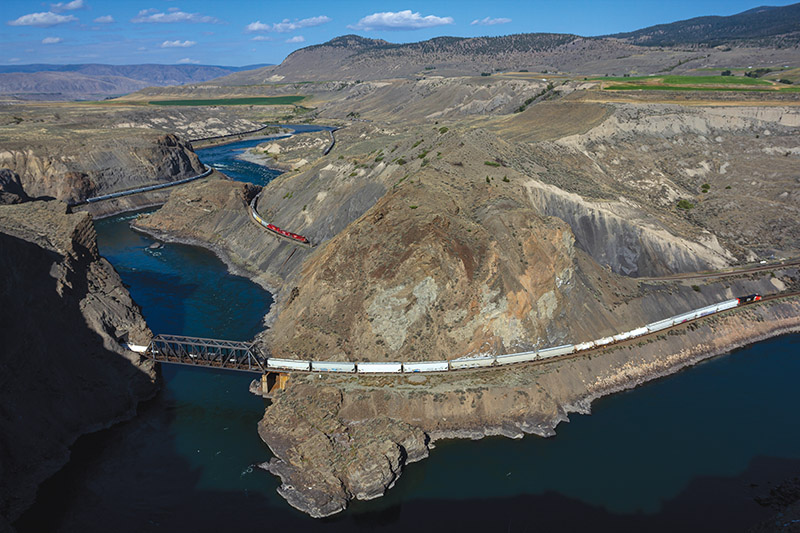 A.J. Shewan’s view of two trains in the Thompson River Canyon won the 2021 Center Spread Contest.
A.J. Shewan’s view of two trains in the Thompson River Canyon won the 2021 Center Spread Contest.
But you don’t need to be flying a drone in a dense metropolis to take a winning shot. Check out, for example, A.J. Shewan’s 2021 winner of two trains in British Columbia’s Thompson River Canyon. A.J.’s view from the top of the canyon is spectacular, but what pushed it to the top was that he got not one train, but two in the perfect spot to fill the scene. It’s an image that deserves to be seen “big” and also proves that sometimes you just get lucky.
Of course, there are exceptions to every rule. Take Eugene Armer’s 2022 winner of a CSX Transportation freight train at Bear Mountain Bridge along the Hudson River before sunrise. While there are some great details in the image — the lights of a distant town along the water and the lines of the suspension bridge — it is not as detailed as the above-mentioned shots. It is simply a prime example of how a shot can rise to the top because of good old-fashioned light and composition.
Photo contests are a great way to get your work before a wider audience and it’s always fun to get a well-deserved pat on the back in print. If you’ve never entered a photo contest, give it a shot and you might surprise yourself. As Wayne Gretzky once famously said, “You miss 100 percent of the shots you don’t take.” Besides our Center Spread Contest, be sure to keep an eye out for the Center for Railroad Photography & Art’s annual competition, which is usually announced in winter and the winners selected in early summer. As for the 2024 edition of the Center Spread Contest, keep reading Railfan & Railroad in print and online for details about when we’ll be looking for submissions.


